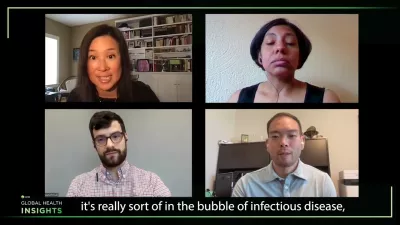Antimicrobial resistance is the biggest threat to the Americas
Published August 8, 2023

Key takeaways:
- Antimicrobial resistance (AMR)is a significant threat in all 35 countries in the Americas.
- There are two distinct problems: 1) a high burden of infectious diseases and 2) countries where a concerning proportion of infections involve AMR.
- We discuss the new research with co-authors Lucien Swetschinski and Daniel Araki, as well as Dr. Gisela Robles Aguilar of Oxford University.
In seven countries – Bolivia, Brazil, Chile, Haiti, Dominican Republic, Uruguay, and Peru – the resistance-associated infections were the third largest leading cause of death, only losing out to cancers and heart disease.
This transcript has been lightly edited for clarity.
Pauline Chiou: Welcome everyone, to another episode of Global Health Insights, a podcast tackling the pressing health challenges we see in the world today. And this podcast is part of the Institute for Health Metrics and Evaluation, or IHME. I'm Pauline Chiou in media relations at IHME.
Today's topic is antimicrobial resistance, or AMR, and specifically about research that recently has been done in the Americas. And we are fortunate to have the research team with us. We have co-authors and researchers at IHME, Lucien Swetschinski and Daniel Araki, as well as co-author and researcher, Dr. Gisela Robles Aguilar of the University of Oxford, and also a great contributor to IHME. So thank you, the three of you, for being with us on this podcast.
Let me start out, just big picture. You researched AMR in 35 different countries in the Americas. What are the key messages that you want the public to take away from this paper?
Daniel Araki: Yeah, so I think the biggest point is going to be that, you know, antimicrobial resistance is a threat to all 35 countries in the WHO region of the Americas. You know, from the wealthy, all the way down to those with more limited access to health care. We're all in this together.
Another key point that we found is that more than two out of five deaths with infections were associated with resistance. And of those, about 25% were attributable to antimicrobial resistance. And all of that kind of adds up.
So in seven countries, so Bolivia, Brazil, Chile, Haiti, Dominican Republic, Uruguay, and Peru, the resistance-associated infections were the third largest leading cause of death, only losing out to cancers and heart disease. So this is really a large and complex problem that we're dealing with.
Pauline Chiou: So, Daniel, you're painting the picture that it's really a global issue. And we do know that AMR has been monitored for the past at least three decades. But then you look at some of the statistics in your paper, and this is to the rest of the research team, more than half a million deaths were associated with AMR in 2019. So even after monitoring for three decades, how did it get so serious?
Dr. Gisela Robles Aguilar: Yes, since penicillin was first used in the 1940s as an antibiotic, bacteria have been developing more mechanisms to resist and to overcome the uses of antibiotics.
And scientists are also increasingly finding it difficult to find new antibiotics. So, it’s, as Daniel said, it's a problem in which we could all contribute and, all contributions should be to keep the antibiotics that we have available and effective to fight antibiotics, and delay the time in which they become obsolete.
So this is one aim of this study, to precisely describe the problem that we are facing. This is the first paper that makes the assessment of the loss occurring from AMR, and also comparing it to other causes of death, such as cardiovascular diseases or cancer, which are also very prominent in the region.
It is precisely this accurate measurement and description that is done nowadays that was possible to, and thanks to the data that has been collected over the past 30 years, as you mentioned.
Pauline Chiou: Yeah, and it's really interesting, Lucien, to look at the geography because your paper really drills down into certain countries and when you look at the highest rates of antimicrobial resistance, the countries that pop up are Haiti, Bolivia, Guatemala, Guyana and Honduras.
So can you speak to what exactly is happening in these countries, and how we should read this, and why it’s so hard to manage?
Lucien Swetschinski: Yeah, so I think, and there's a little bit a nuance to that statistic that you presented, that finding would be surprising to many, who might think that places where antibiotics are used more frequently, you would have greater rates of resistance.
And, indeed, we actually do see absolute levels of resistance.So the amount of pathogens that are resistant to an antibiotic are higher in certain countries where there is more prevalent antibiotics. So then going back to an example like Haiti, where we're seeing a lot of burden of AMR, something that's important to understand here for context, is that AMR fits within this bigger bubble of infectious disease.
And where there is more infection, there is a greater potential and capacity for this AMR burden. So when you look at the Americas, you have this tremendous diverseness, or heterogeneity of wealth. You have countries like Haiti and Bolivia compared in the same paragraph to countries like Canada, the US, Chile, Argentina, and the availability of health care, the quality of health care in these countries is very diverse.
And the issue that we're seeing in the countries that you listed is not so much rampant antibiotic use, but more so just uncontrolled levels of infection, particularly sometimes infection among newborns, infection among the elderly, things like pneumonia and meningitis.
Meanwhile, you have countries like Chile that have very low rates of AMR burden, but when you look at the amount of AMR within the envelope, as we call it, of infectious disease, you see that there is, a very, very high proportion of their infections involve AMR, which is concerning to us because that means that AMR is progressing in that country, and, if left unchecked, you could get an uncontrollable problem.
Pauline Chiou: So it's very helpful that you put that all into context and saying that, you know, it's really sort of in the bubble of infectious disease, that's a really important point, and Lucien did mention newborns, and the paper looks at the rate of AMR deaths within newborns and then how it progresses in childhood.
So help us understand what's happening from a young age, because the rate is quite high in the Americas, among newborns.
Dr. Gisela Robles Aguilar: Yes, this is a finding that, it's not surprising, newborns are extremely vulnerable to infections. So, they are also in very close contact in, to health care settings where bacteria develops and especially resistant bacteria.
So they rely heavily on antibiotics to fight, to help them fight this infection. But as the child grows, their immune system develops, they are breastfed, receive vaccinations, and they are, have better tools to fight infections themselves.
So the AMR burden across older, as people grow older, the burden decreases. But there are other populations that are extremely vulnerable to bacteria and bacterial infections, and resistant bacteria, which are people who have a weakened immune system or have to go through a surgical procedure.
They are, at that point they become very vulnerable to infections, and also older populations in a home care settings that are in close contact to bacteria which become resistant.
So it's our duty to maintain these antibiotics working. Because they rely heavily on the use of antibiotics to fight infections.
Pauline Chiou: So the big question, as you’re all painting this picture of how complex the situation is, and the different groups that are vulnerable, the big question is, you know what can health care providers or policymakers do in terms of finding solutions, or what the most proactive next steps are? And does it depend country by country?
Daniel Araki: Yeah, so I believe we were able to identify, you know, common pathogens and their
respective resistances leading to increased burden in all these countries. And to do this, we rely on the available data that has been previously mentioned from these countries, and policymakers
can start with steps in that direction, you know, increasing this availability of data.
It’s also worth noting that microorganisms don't recognize human borders and a neighbor's problem could very well be your own problem too. So regional partnerships become very important in this regard of data sharing.
And then with this informed data, providers and policymakers can think about how to proactively guide drug usage, increase access to alternative drugs and treatments, and most importantly, how to improve prevention of these infections in the first place.
Pauline Chiou: So let's just say in an ideal world, the data sharing across borders becomes better, Lucien, I'll let you have the final word in the podcast. What would you say the low hanging fruit is in terms of solutions, and what the complex challenges are?
Lucien Swetschinski: Yeah, so I think when you look at the most cost-effective solution that's available to us, it really is reducing the rates of infection in these countries where infection is rampant.
So that's improving the quality of water, sanitation and hygiene. And we identify those countries in our paper that seem to be suffering more from the infection problem than from the AMR problem. So that's certainly a low hanging fruit.
Another low hanging fruit might be improving the quality of surveillance in these higher income countries, extending that surveillance to certain pathogens that are unmeasured but could potentially be developing resistance, kind of in secrecy, as it were, because we're not measuring them.
And then when we think about the more challenging problems, there is a big issue about diagnostic capabilities in hospitals. So when you have antimicrobial resistance in a world with antimicrobial resistance, you have to know whether the patient you're working with is suffering from that problem. And that requires a certain laboratory analysis and all sorts of other high technological machinery and work.
And there is going to be a challenge to scale up that diagnostic capability in these lower-resource settings. There should be a regional or continental push towards improving this capability because, as Daniel mentioned, the problems of our neighbors are not solely their problems. They’re our problems too.
So we really need to improve this diagnostic capability because without it you're just sort of prescribing antibiotics in the dark. And that has kind of gotten us here in the first place. So that's another, that's the more complex problem.
And then another problem that we don't really know how complex it is because the incentives haven't quite been there yet, but it's the development of these new antibiotics or vaccines. Vaccination is really
ideal because then you don't need any antibiotics whatsoever. You just cut off infection at the source, you prevent all these sorts of infections.
But a lot of these antibiotics and vaccines aren’t necessarily cash cows, they're not big moneymakers. So we need to think about how, and this is a global problem as well, certainly because the development of these drugs could be extended to any part of the world.
Pauline Chiou: Yeah. You bring up such great points. I mean, this conversation was about data sharing, improving diagnostic testing, improving sanitation, the development of antibiotics. There's a lot to chew on. Thank you so much, Lucien Swetschinski and Daniel Araki of IHME, and Dr. Gisela Robles Aguilar of the University of Oxford.
If people want to learn more they can read your research paper and listen to this podcast as well. Thanks so much.
